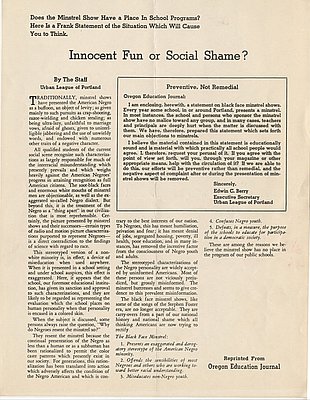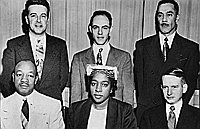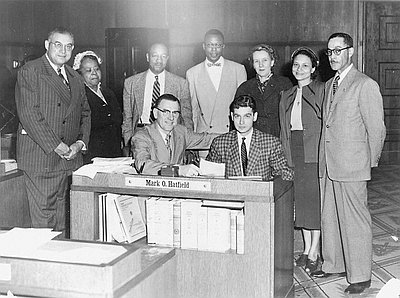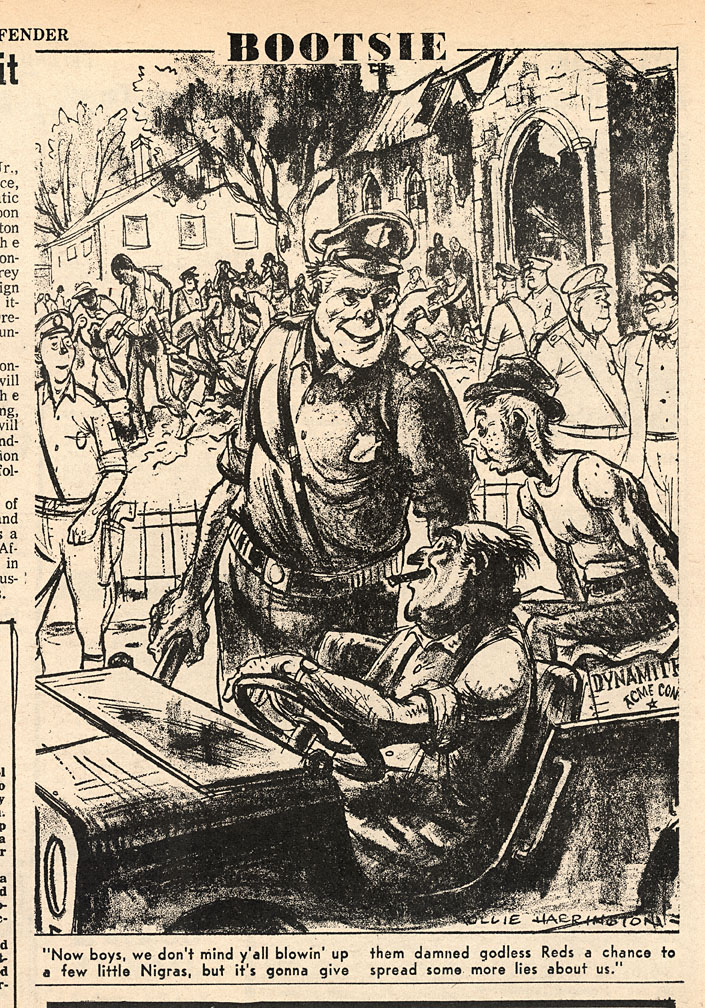- Catalog No. —
- Mss 1585
- Date —
- October 15, 1964
- Era —
- 1950-1980 (New Economy, Civil Rights, and Environmentalism)
- Themes —
- Arts, Black History, Government, Law, and Politics, Race, Ethnicity, and Nationality
- Credits —
- Courtesy of Walter O. Evans Collection of African American Art
- Regions —
- Portland Metropolitan
- Author —
- Oliver W. Harrington, Northwest Defender, 10-15-1964
Bootsie Cartoon
This particular “Bootsie” cartoon appeared in the Northwest Defender, a Portland-based African American weekly, in October of 1964, a year after a church bombing in Birmingham, Alabama, had killed four young African American girls. Ollie Harrington was living in Soviet-controlled East Berlin when he created and published this cartoon.
As the caption makes clear, race-based violence in the United States provided communist countries with an easy target for their anti-American propaganda. Foreign policy experts and advisors of the U.S. government were well aware of the international consequences of domestic race-based violence, intimidation, and discrimination. In World War II, the U.S. Department of War Information was particularly concerned about “the degree to which Nazi propaganda, and even more Japanese propaganda, was having its effect on the attitude of the Negroes toward the war.” The U.S. State Department had also learned, by the mid-1960s, that the nation’s political interests in Latin America and Southeast Asia were threatened by violence, discrimination, and xenophobia expressed by American whites toward the nation’s non-white minorities.
During the Cold War, the Soviets used racial discontent in the U.S. to discredit American efforts to “democratize” the world. The high stakes of the Cold War induced foreign policy experts such as Secretary of State John Foster Dulles to openly denounce racial discrimination as “morally wrong” and “stupid,” warning that “[i]f we choose to be exclusive on racial or religious lines, we will find ourselves to be a perilously small minority in a hostile world.” The international consequences of institutional racism in the United States became an important motivation behind governmental efforts to reform racist laws and business practices domestically. At the same time, the burgeoning civil rights movement, whose leadership was aware of the importance of international opinion, did their best to make sure that the struggle for racial equality in the United States was covered by the world’s media.
Oliver “Ollie” Wendell Harrington was born in New York City on February 14, 1912, the son of a Jewish Hungarian mother and African American father. Before moving to Europe in 1951 to avoid testifying before the House Un-American Activities Committee, Mr. Harrington had taken part in the later years of the Harlem Renaissance in New York City, earned a bachelor of fine arts degree at Yale University, served as a war correspondent during World War II, and spearheaded public relations for the National Association for the Advancement of Colored People. From the 1930s through the 1980s, he published his cartoons in American and European papers such as New York’s Amsterdam News and Daily World, Baltimore’s Afro-American, Pittsburgh’s Courier, and East Germany’s Eulenspiegel and Das Magazine. His work has been described as “art with the edge of a razor” and he was especially critical of institutional racism and violence.
Further Reading:
Inge, M. Thomas, ed. Dark Laughter: The Satiric Art of Oliver W. Harrington. Jackson, Miss.: 1993.
Borstelmann, Thomas. The Cold War and the Color Line: American Race Relations in the Global Arena. Cambridge, Mass. 2001.
Hart, Justin. “Making Democracy Safe for the World: Race, Propaganda, and the Transformation of U.S. Foreign Policy during World War II.” Pacific Historical Review 73, 2004: 49-84.
Written by Joshua Binus, © Oregon Historical Society, 2003.
Related Historical Records
-
"Innocent Fun or Social Shame?"
This document was created for school administrators by the Urban League of Portland sometime in the 1950s in an effort to stop minstrel, or blackface, productions in schools. …

-
Origins of a Civil Rights Movement
Just as the city’s commercial and entertainment foundations began to shift, so too did its population. The influx of war workers, including unprecedented number of Blacks, turned the …

-
Oregon's Civil Rights Bill, 1953
The proponents of Oregon’s Civil Rights Bill, also known as the Public Accommodations Bill, pose for posterity. Seated, from left: Philip S. Hitchcock and Mark O. Hatfield. Standing, …

